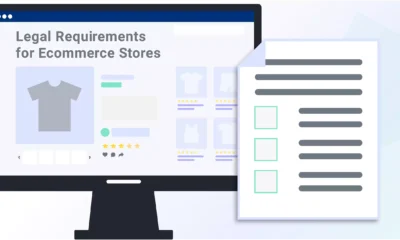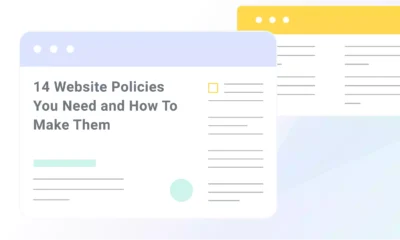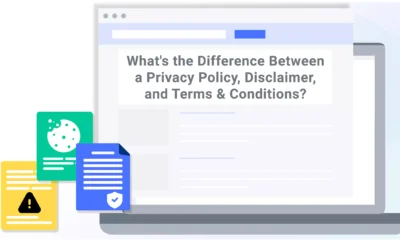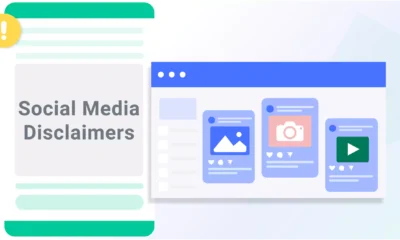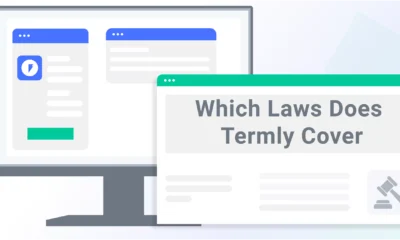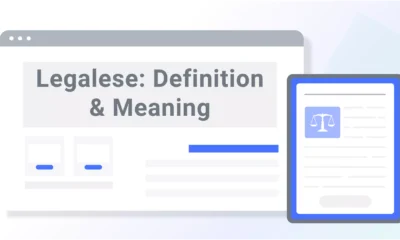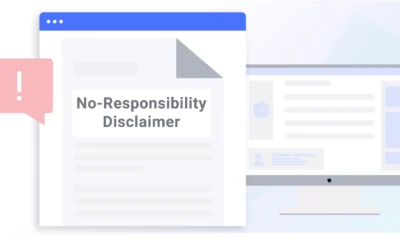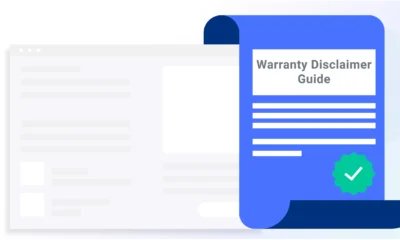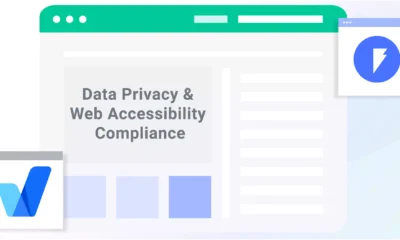Even though copyright law automatically protects original materials, posting a copyright disclaimer on your website or app informs users abou the rights you retain over your content.
Below, I explain more about what copyright notices are, why you might need to post one on your website or app, and present you with real-life copyright examples to help you write your own copyright notice.
What Is a Copyright?
A copyright is the exclusive legal right over how original content or materials you’ve made get copied, shared, reproduced, printed, performed, or published by others.
In other words, copyright provides you with exclusive rights to:
- Reproduce your work
- Distribute or sell your work
- Display or perform your work publicly
- Create derivative works based on the original work
It also allows you to authorize or restrict others in exercising these rights, further protecting your original works if they’re ever stolen or plagiarized.
A copyright usually consists of the following four components, which I’ll discuss in more detail later in the article:
- Copyright symbol © or the word “copyright”
- Year the material was published
- Name of the copyright owner
- What rights are retained by the copyright
Some examples of copyrighted works include:
- Art
- Literature
- Videos
- Images
- Photography
- Choreography
- Music
- Sound clips
Copyright Laws Around the World
Copyright laws vary around the world, and there is no global version of copyright, but many countries are part of the Berne Convention, which deals with protecting original works and the authors’ rights over them.
Established in 1886, countries under this convention agree to recognize a set of legal principles for protecting original content across country borders.
However, there are subtle differences in how copyright law works in each location, so I’ll briefly touch upon the relevant laws in the following countries, all of which are part of the Berne Convention:
- The United States
- The United Kingdom
- The European Union (EU)
- Australia
- Canada
Copyright in the US
In the US, your original materials are protected by copyright law as soon as you create something and release it publicly, even if you don’t post a copyright notice.
But if you want to ensure further protection of your works and potentially limit paying costly legal fees down the road, adding a copyright notice to your content may help deter:
- Copyright infringement
- Unauthorized reproduction, distribution, or displaying of copyrighted materials
You may also choose to register your copyright with the US Copyright Office.
Copyright in the UK
Copyright laws in the UK protect your original materials automatically. You do not have to apply for protection, register your work, or pay any fees for the law to protect your original creations, including:
- Literary works
- Dramatic works
- Music
- Works of art
Copyright in the EU
In the EU, copyright applies to your intellectual property until 70 years after your death or 70 years after the death of the last surviving author in cases of joint authorship.
But in the EU, there is no equivalent “fair use” doctrine, like in the US. Instead, there is a list of explicit exceptions that cover specific scopes.
Copyright in Australia
Like in the US, UK, and EU, Australia’s copyright law protects your creative works the moment you put your creative idea on paper, online, or any other form of documentation.
You do not need to register your work, as the protection is free and automatic under Australia’s Copyright Act 1968.
Copyright in Canada
As of 2022, copyright in Canada applies to your work automatically and lasts the author’s lifetime plus 70 years past their death.
Previously, the protection only lasted for 50 years past the author’s death.
What Is the Difference Between a Copyright and a Trademark?
The difference between a copyright and a trademark is the type of content each notice protects — trademarks apply to logos, slogans, and brand identity. In contrast, copyright applies to original tangible materials and creative works.
You technically own a trademark as soon as you start using a name or brand identity along with your goods or service, making it similar to how copyright law works.
While you’re not legally required to register your trademark with the United States Patent and Trademark Office (USPTO), doing so gives you broader rights and protections than when left unregistered.
For example, registering your trademark in the US grants you national recognition and creates nationwide rights.
Once registered, you can use the trademark symbol, which looks like an R with a circle around it: ®
But if your trademark is unregistered, you must use the abbreviation ‘TM’. However, if you’re trademarking a service, you may also use the initials’ SM’, meaning service mark, but both are still referred to as trademarks.
You can use the logo or abbreviations whenever you use your trademarked identity, or you can use it as superscript or subscript text.
Copyright Examples & Types
There are technically two types of copyright examples, one allows you to reuse copyrighted materials in specific ways for “fair use” purposes without the owners’ permission, and the other protects your content from reuse or reproduction as the owner of the work.
Let’s go over each type of copyright example in a little more detail in the following sections.
Copyrighting Works of Creative Expression
According to the US Copyright Office, copyright applies to all original works of creative expression captured in a tangible form and goes to the work’s original creator, who can choose to sell their rights to other parties.
Some examples of works that can be copyrighted include:
- Architectural works
- Sound recordings
- Audiovisual works — including motion pictures
- Artworks
- Dramatic works — including any accompanying music
- Musical works — including any accompanying words
- Literary works
- Choreographic works
That said, there are limitations to the types of work this protection applies to.
The following examples of content aren’t protected by copyright:
- Ideas, methods, systems, concepts, or discoveries
- Works that don’t have a tangible form (i.e., not captured in a physical medium)
- Titles, names, slogans
- Familiar symbols or designs
- Variations of typefaces or lettering
- Ingredient lists
“Fair Use” and Section 107 of the Copyright Act
You are allowed to legally reproduce or reuse certain aspects of a copyrighted work without the owners’ explicit permission for the following reasons, which qualify as “fair use” under section 107 of the Copyright Act:
- Commentary — i.e., copying paragraphs from a news article, scientific paper, or medical journal for educational purposes
- Criticism — i.e., quoting song lyrics or summarizing movie scenes for a critical review
- Parody — i.e., mimicking, making light of, or satirizing something in a comedic way
If you’re using someone else’s content for “fair use” purposes, it’s in your best interest to post a copyright disclaimer or a fair use disclaimer stating as much to help prevent an unfair or unnecessary copyright strike.
However, a disclaimer cannot guarantee that you won’t receive an unfair strike.
For this reason, I recommend getting explicit permission from the copyright owner to use their materials whenever possible.
While “fair use” copyrights are essential in many cases, the focus of this guide is primarily on the copyright that applies to protecting your usage rights over original content.
Do You Need a Copyright Notice?
While you don’t legally need a copyright notice for the law to cover your original works, it’s a best practice to put a disclaimer on all your published materials for the following reasons:
- Reason #1: Having a copyright notice posted on your website or app helps add an extra layer of protection if infringement does occur because you can prove that the infringer should’ve seen the copyright and been aware that your content was protected
- Reason #2: Copyright notices are very quick and easy to make and typically consist of four concise components
- Reason #3: Including one acts as a visual reminder to your users that your work is protected by copyright, and users may assume otherwise if they do not see a notice
- Reason #4: A visible copyright reduces the chances of copyright infringement because it proves that you’re aware of the law and are willing to follow through on your rights if anyone misuses your work
It’s also in your best interest to post a fair use copyright notice if you’re reusing someone else’s copyrighted materials for commentary, criticism, or parody purposes.
While it can’t prevent someone from submitting an unfair copyright strike against you, it may help reduce the chances.
Benefits of a Copyright
There are several benefits to including a copyright on your website or app.
Copyrights Are Quick and Easy To Make
Making a copyright for your website or app is very quick and easy, so there’s little to no reason not to include one to remind users that you own the rights over your content.
There are only four simple components you need to include:
- The copyright symbol © or the word “copyright”
- The name of the copyright owner or author of the work
- The year the content was published, which can be different from the year of creation
- Your statement of the rights you’re reserving over the materials
This screenshot labels all four copyright components from the United Parcel Service’s (UPS) website.

As you can see, they used both the copyright symbol and the word “copyright”, included a range of years, named themselves as the copyright owner, and reserved all rights.
I recommend you post a copyright notice in the footer of your website, like how UPS did it above. It’s fast, easy, and helps protect your materials better.
Copyrights Provide Extra Protection
Including a copyright notice protects your creations because it gives you something to point to as proof of ownership. It also helps you prove that any offenders should’ve seen the statement and been aware of the rights you retained over the materials.
Plus, not all users know about copyright laws. If they don’t see a notice, they might wrongfully believe they can freely use your materials when that is not legally the case.
Copyrights May Help Save You Money in Legal Fees
A copyright notice is usually free to post on your website or app and may reduce the number of copyright infringement cases you experience — that’s much cheaper than waiting until you have to rely on a lawyer.
In 2022, the average cost of a lawyer specializing in intellectual property cases averaged $342 an hour. (Statista)
Can You Copyright AI-Generated Content?
You may be wondering if you need to copyright AI-generated content — or if it’s even possible to copyright it in the first place.
Since this technology is advancing rapidly, many businesses are turning to artificial intelligence to help jump-start tasks to save time, like writing emails with AI or generating customized business logos created by AI for their brand.
Currently, government entities are still debating if such content falls under copyright laws or not. Some suggest that because a machine and not a human created it, it cannot fall under these copyright laws.
Others suggest that because AI models are created and influenced by humans, the content may fall under derivative work. Derivative works are creations based on an original piece of copyrightable content.
In Spring 2023, the U.S. Copyright Office held multiple listening sessions discussing this topic and released guidance on the matter. According to their AI Policy Guidance, when submitting a copyright application, you must disclose what portions of the content come from an AI and which portions were created by a human. The AI contributions cannot be copyrighted unless they’re de minimis — a fancy way of saying trivial or minor.
So, for now, play it safe and add a copyright disclaimer that clearly explains what portions of your materials were created by humans versus what was generated by an AI or machine learning model.
How To Write a Copyright Notice
To write your own copyright notice, you must include some or all four of the following components in this order:
- The copyright symbol © or the word “copyright”
- The year the material was published — you may include a range of years if your content is regularly updated, and this can be different from the creation date
- The name of the copyright owner — this can be an individual, multiple people, an organization, or a business
- Your statement of rights you wish to retain over your materials — some, all, or none
What do the different statements of rights mean?
- All rights reserved: You own and retain all rights to your work
- Some rights reserved: You allow the use of your materials under certain circumstances, which you should specify in an intellectual property rights clause somewhere on your site, like in your terms and conditions agreement
- No rights reserved: You release your work into the public domain
Putting the statement of your rights in your copyright is optional. If you don’t add it, then it’s legally assumed you retain all rights.
How and Where To Display a Copyright Notice
Your copyright notice should be displayed conspicuously so that anyone who views your work knows that it’s copyrighted.
The placement of your copyright notice depends on the type of work or content you’re putting your notice on, but I suggest the following locations.
Copyright in Your Website Footer
The most common place to put a copyright notice is the footer of your website, so I recommend including it there, as this is where users expect to find it.
I recommend using a visible, readable font and including as many of the components you feel are necessary to establish ownership of your content.
In the screenshot below, see a copyright example from the footer of the Starbucks website.

Copyright in Your Mobile Apps
For app developers, you should include a copyright on the description or purchase pages of any app store that hosts your product so users see it before downloading and accessing your services.
Below, see a copyright example from Ulysses, a one-stop writing app hosted in the Apple App Store.

Copyright in Your Email Footers
If you send marketing emails to your consumers that contain product updates, videos, imagery, or written materials you don’t want to be copied and reproduced, include a copyright in the footer of all of your emails.
Take, for example, the copyright from Apple’s iCloud marketing emails, pictured for you below.

Copyright on Downloadable Materials
If you want to protect content you allow users to download, include a copyright notice on the document or product.
By doing so, you ensure that anyone who accesses the downloaded versions of your materials knows it’s protected by copyright law.
Additional Copyright Locations
There are some other examples of standard copyright notice placements for various works, like:
- Books or ebooks often have a copyright page at the beginning or end of the book
- Photos and other forms of digital art often have a copyright near the bottom of the work or a watermarked label
- YouTube videos often have a copyright notice in the video description or video credits
But it’s important to note that you can’t just slap a copyright on whatever you want and expect it to legally protect you — there are exceptions, like fashion or personal styles, commonly known information, or anything considered an idea, method, or system.
Copyright Notice Examples
Now let’s look at some real examples of copyright notices, which I’ll break down into the four relevant components mentioned above.
Pixar’s Copyright Example
In the screenshot below, see the components included in Pixar’s copyright, which is in their website footer and follows the standard copyright format.

As you can see, they include the following copyright components in their notice:
- They use the © symbol
- 1986-2025 is the range of dates covered by their copyright
- Disney/Pixar is the name of the copyright owner
- There is no statement of rights, which means they reserve all rights over their property
Like the Pixar copyright example, your statement can include a range of years if you’ve expanded or updated your content since the original publication date.
In the following screenshot, you can view the clause Pixar includes in their terms of use agreement that expands upon their copyright and lists all intellectual property it covers.

I also recommend including a similar clause in your terms of use agreement.
It helps answer any questions users might have about what your copyright covers and explains the legality of reusing, redistributing, or copying your content.
The Yale University Art Gallery Copyright Example
Next, let’s look at a copyright example from the website footer of the Yale University Art Gallery.

Yale clearly includes all four components in their copyright notice:
- They use the word “copyright” and the © symbol
- The copyrighted year is 2025
- The name of the copyright owner is the Yale University Art Gallery
- They have reserved all rights
Yale also links their terms and conditions directly under their copyright. When clicked on, you can navigate to a copyright page that informs users that they trademarked their branding, as shown below.
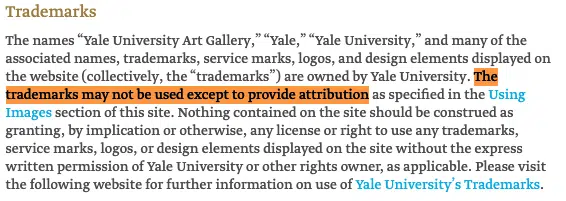
As the highlighted text above explains, the Yale-specific trademarked branding and materials cannot be reproduced except to provide attribution.
The notice then goes on to explain that they participate in an open access policy regarding photos in their art collection that are now part of the public domain, also shown for you below.

The copyright statement specifies that some of the images from the site are part of the public domain, meaning they’re free for anyone to use.
Like this example copyright notice, you can add an “All rights reserved” statement to your copyright footer to declare full ownership over your content, then link to a copyright notice page or your terms and conditions agreement to provide more information about the specific or nuanced details.
Costco’s Copyright Example
Another great example of a copyright page comes from Costco, who posts the following copyright notice in their website’s footer.

To translate this into the four primary components of a copyright, Costco:
- Uses the © symbol
- Puts the date range 1998-2025
- Names themselves, Costco Wholesale Corporation, as the owner
- Retain all rights over their property
Within their terms and conditions, they include a copyright page that expands upon their notice even further, providing users with a way to report potential copyright claims and explaining what they’ve also trademarked.
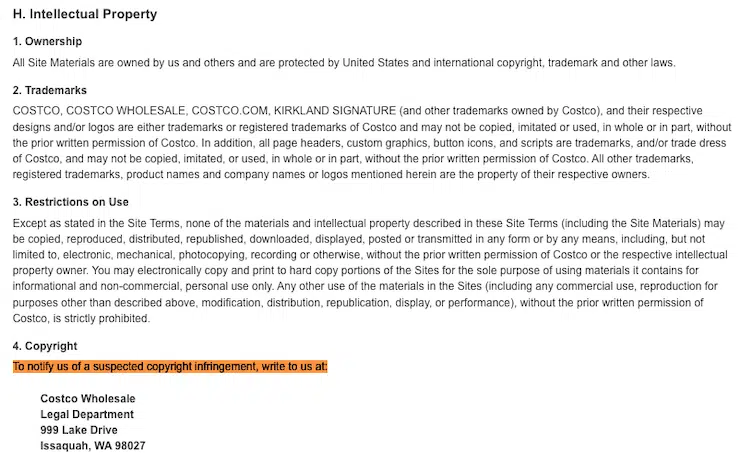
You should also consider providing a way for your users to notify you about suspected copyright infringement, similar to how Costco does it.
Your consumers might spot breaches you miss, which helps you take care of unwanted reproduction of your materials more efficiently.
Copyright FAQ
If you still have questions, I’ve got more answers. In the next section, check out some of the most frequently asked questions we get about copyrights.
Do I need a copyright?
You don’t need to post a copyright for your original work to be protected by copyright law, but using one can act as a warning to others and help prevent people from stealing or misusing your work.
Why should I use a copyright?
You should use a copyright notice to inform others about what rights you’re retaining over your materials, to prevent people from misusing or stealing your work, and to potentially avoid expensive legal fees down the road.
Can I copy someone’s copyright notice?
No, do not copy someone else’s copyright notice, as it won’t have the correct information to apply to your work. Instead, make your own copyright that includes the following details:
- The word ‘copyright’ or the © symbol
- The year you published the materials
- Name of the copyright owner or author
- What rights you’re reserving
Where do I put my copyright?
Put your copyright in the footer of your website or app, on the description page of any app stores that host your service, in the footer of any marketing emails you send, and on any downloadable materials you publish.
What types of copyrights are there?
There are two types of copyrights: one protects content you own from being reused or reproduced without your permission, and the other allows you to reuse other copyrighted materials without the owners’ permission for “fair use” purposes.
Commentary, criticism, and parody are considered “fair use”.
All of the following are types of copyrightable materials:
- Literary works
- Musical works
- Dramas or performances
- Choreography
- Sound recordings
- Photography
- Videos
- Graphics
- Sculptures
- Branding and designs
What are some examples of copyrighted materials?
Some examples of copyrighted materials include:
- Written works
- Music
- Dance
- Choreography
- Videos
- Images or photography
- Graphic designs and branding
- Sound recordings
- Plays or dramatic works
Summary
In countries part of the Berne Convention, copyright laws ensure creative works are covered the moment they’re created, keeping content safe from theft and copyright infringement.
But even though copyright laws protect original materials without requiring a disclaimer, it’s in your best interest to put a copyright notice somewhere on your website or app.
This way, you can inform others that you intend to retain all rights over your content and clearly show that your work requires authorization for use, which strengthens your protection over your original materials and helps you avoid potential legal fees by discouraging copyright infringement before it starts.




